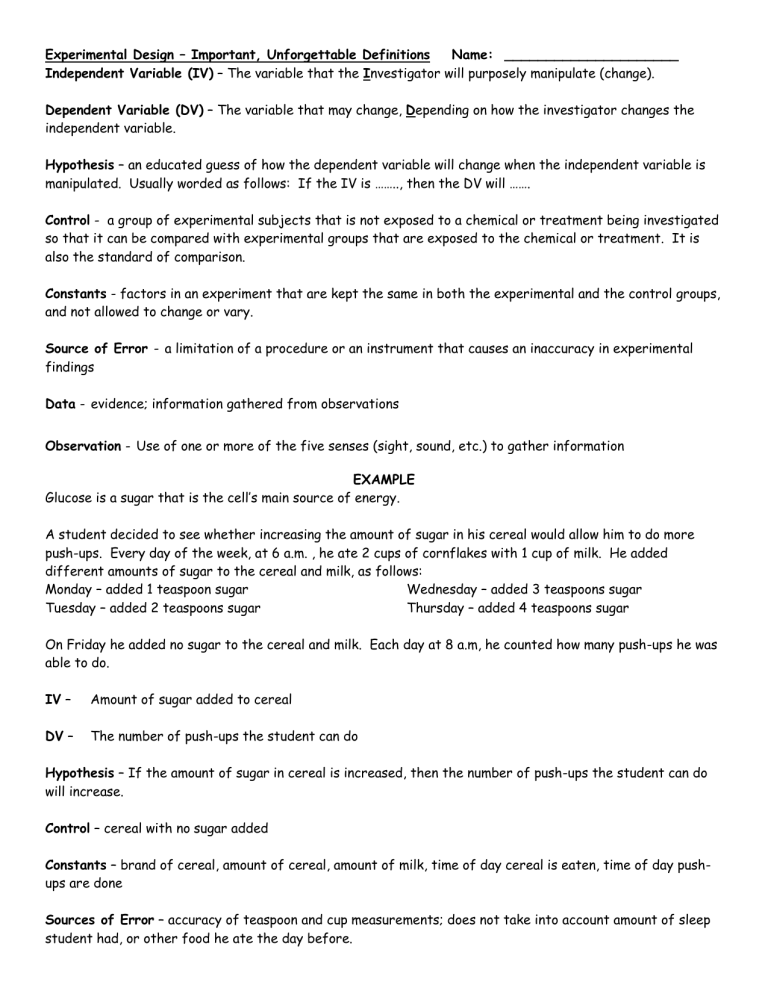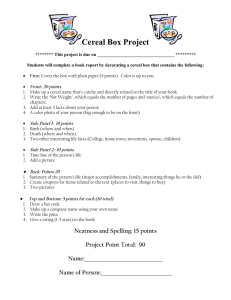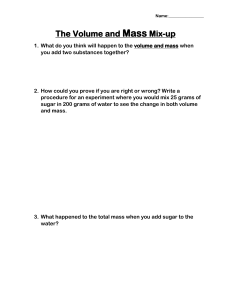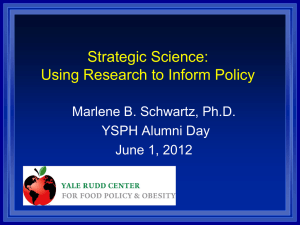
Experimental Design – Important, Unforgettable Definitions Name: _____________________ Independent Variable (IV) – The variable that the Investigator will purposely manipulate (change). Dependent Variable (DV) – The variable that may change, Depending on how the investigator changes the independent variable. Hypothesis – an educated guess of how the dependent variable will change when the independent variable is manipulated. Usually worded as follows: If the IV is …….., then the DV will ……. Control - a group of experimental subjects that is not exposed to a chemical or treatment being investigated so that it can be compared with experimental groups that are exposed to the chemical or treatment. It is also the standard of comparison. Constants - factors in an experiment that are kept the same in both the experimental and the control groups, and not allowed to change or vary. Source of Error - a limitation of a procedure or an instrument that causes an inaccuracy in experimental findings Data - evidence; information gathered from observations Observation - Use of one or more of the five senses (sight, sound, etc.) to gather information EXAMPLE Glucose is a sugar that is the cell’s main source of energy. A student decided to see whether increasing the amount of sugar in his cereal would allow him to do more push-ups. Every day of the week, at 6 a.m. , he ate 2 cups of cornflakes with 1 cup of milk. He added different amounts of sugar to the cereal and milk, as follows: Monday – added 1 teaspoon sugar Wednesday – added 3 teaspoons sugar Tuesday – added 2 teaspoons sugar Thursday – added 4 teaspoons sugar On Friday he added no sugar to the cereal and milk. Each day at 8 a.m, he counted how many push-ups he was able to do. IV – Amount of sugar added to cereal DV – The number of push-ups the student can do Hypothesis – If the amount of sugar in cereal is increased, then the number of push-ups the student can do will increase. Control – cereal with no sugar added Constants – brand of cereal, amount of cereal, amount of milk, time of day cereal is eaten, time of day pushups are done Sources of Error – accuracy of teaspoon and cup measurements; does not take into account amount of sleep student had, or other food he ate the day before. Practice #1 A student noticed that on a hot, sunny summer day at the beach, an empty soda can became too hot to touch. She also noticed that an empty soda can her little brother had filled with water became warmer, but not hot. She decided to take 6 empty soda cans and fill them with varying amounts of water, as follows: Can 1 – added 10 ml. water Can 4 – added 40 ml. water Can 2 – added 20 ml. water Can 5- added 50 ml. water Can 3 – added 30 ml. water Can 6 – added 60 ml. water She took a 7th empty can, and added no water to it. She also placed a thermometer into each can. She then set the cans on a picnic table at the beach, in the sun. After the cans had been in the sun for 2 hours, she measured the temperature in oC for each can. 1. What was the student’s hypothesis? 2. What was the IV? 3. What was the DV? 4. What was the control? 5. What were the constants? 6. What are possible sources of error? Practice #2 Design an experiment in which you will see how the amount of butter added to breakfast toast affects a student’s ability to do sit-ups each day. 1. What is the IV? 2. What is the DV? 3. What is your hypothesis? 4. What will be your control? 5. What will be your constants? 6. What are possible sources of error? 7. Briefly describe the set-up of your experiment (i.e, When will the toast be eaten, when will the sit-ups be done, ETC.?)





